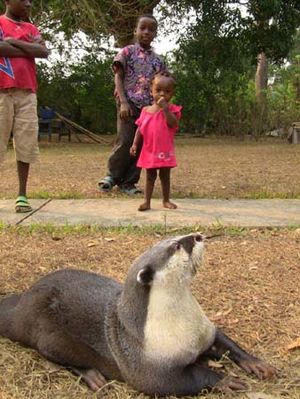Congo clawless otter facts for kids
Quick facts for kids Congo clawless otter |
|
|---|---|
 |
|
| Conservation status | |
| Scientific classification | |
| Genus: |
Aonyx
|
| Species: |
capensis
|
 |
|
| Congo clawless otter range | |
The Congo clawless otter (Aonyx congicus) is a special type of otter. It is also known as the Cameroon clawless otter. These playful animals are part of the weasel family. They are known for their unique paws, which have very small claws or no claws at all. This helps them hunt for food in the water.
Contents
Where Do Congo Clawless Otters Live?
These otters live in parts of Africa. You can find them in countries like Cameroon, the Republic of the Congo, and the Democratic Republic of the Congo. They also live in Gabon, Burundi, the Central African Republic, Equatorial Guinea, Nigeria, Rwanda, and Uganda.
Their Home: A Mix of Water and Land
Congo clawless otters are very adaptable. They can live in many different places, called habitats. They love areas with lots of water.
Some of their favorite homes include:
- Rivers and lakes
- Swamps and marshes
- Mangrove forests (trees that grow in salty water)
- Forests that are warm and wet
- Even small ponds, canals, and ditches
They can live in both fresh water and salty water areas near the coast. This shows how tough and flexible they are!
What Do They Look Like?
Congo clawless otters are medium-sized otters. They have sleek, dark fur that helps them glide through the water. Their most special feature is their paws. Unlike most otters, their front paws have very small claws, or sometimes none at all. This gives them a great sense of touch. It helps them find food in muddy water.
What Do They Eat?
These otters are skilled hunters. They use their sensitive paws to feel for food. Their diet mainly includes:
- Crabs
- Fish
- Frogs
- Other small water animals
They are important predators in their watery homes.
Why Are They Important?
Congo clawless otters play a role in their ecosystems. They help keep the balance of nature. By eating crabs and other animals, they help control those populations. This keeps the environment healthy for other plants and animals.
Are They in Danger?
Sadly, the Congo clawless otter is facing challenges. Their biggest threat is habitat loss. This happens when their homes are destroyed or changed. People might clear forests or pollute rivers. This makes it harder for otters to find food and safe places to live.
Conservation groups are working to protect these amazing animals. They want to make sure the Congo clawless otter can thrive for many years to come.


